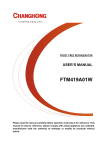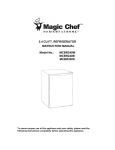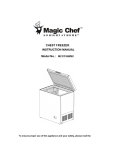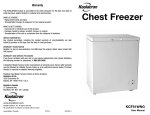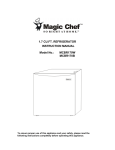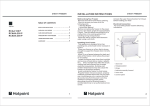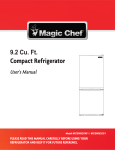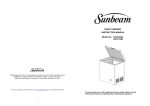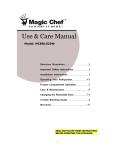Download Changhong Electric FTM320A01W User`s manual
Transcript
FROST FREE REFRIGERATOR USER’S MANUAL FTM320A01W Please read the manual carefully before operation and keep it for reference. This manual is only for reference, please comply with actual appliance you selected. manufacturer hold the authority to redesign or modify its products without notice. NAMES OF THE PARTS 1. FREEZER BIN 2. REFRIGERATOR BIN 3. REFRIGERATOR BIN 4. BOTTLE SHELF 5. FREEZER SHELF 6. FREEZER TEMPERATURE CONTROL KNOB 7. LAMP COVER 8. REFRIGERATOR TEMPERATURE CONTROL KNOB 9. REFRIGERATOR SHELF 10. CRISPER COVER 11. CRISPER 12. LEVELING LEG WARNING: Never touch the interior of the Freezer or frozen foods in the compartment with wet hands as this could result in frost bite. 1 IMPORTANT SAFETY INSTRUCTIONS WARNING To reduce the risk of fire, electrical shock, or injury when using your refrigerator, follow these basic precautions: Read all instructions before using the refrigerator. DANGER or WARNING: Risk of child entrapment. To avoid the possibility of child entrapment, please take the following precautions before throwing out the refrigerator. - Remove all doors from the unit. - Leave the shelves in place so that children may not easily climb inside. Never allow children to operate, play with, or crawl inside the refrigerator. This appliance is not intended for use by persons (including children) with reduced physical, sensory or mental capabilities, or lack of experience and knowledge, unless they have been given supervision or instruction concerning use of the appliance by a person responsible for their safety. Children should be supervised to ensure that they do not play with the appliance. Never clean refrigerator parts with flammable fluids. The fumes can create a fire hazard or explosion. This appliance is intended to be used in household and similar applications such as: - staff areas in shops, offices and other working environments; - farm houses and by clients in hotels, motels and other residential type environments; - bed and breakfast type environments; - catering and similar non-retail applications Do not store or use gasoline or any other flammable vapors and liquids in the vicinity of this or any other refrigerator. The fumes can create a fire hazard or an explosion. If the supply cord is damaged, it must be replaced by the manufacturer, its service agent or similarly qualified persons in order to avoid a hazard. - Please read and save these instructions - INSTALLATION INSTRUCTIONS Before Using Your Refrigerator Remove the exterior and interior packing. Before connecting the refrigerator to the power source, let it stand upright for approximately 4 hours. This will reduce the possibility of a malfunction in the cooling system from improper handling during transportation. Clean the interior surface with lukewarm water using a soft cloth. (Cleaning instruction on page 8) Installing Your Refrigerator This appliance is designed to be free standing only, and should not be recessed or built-in. Place your refrigerator on a floor that is strong enough to support the refrigerator when it is fully loaded. Allow 5 inches of space between the back and sides of the refrigerator, which allows the proper air ventilation. Adjust the feet to keep the refrigerator level. Locate the refrigerator away from direct sunlight and sources of heat (stove, heater, radiator, etc.). Direct sunlight may affect the acrylic coating and heat sources may increase electrical consumption. 2 Ambient temperature below 50°F or above 85°F will hinder the performance of this appliance. This unit is not designed for use in a garage or any other outside installation. Avoid locating the refrigerator in moist areas. Plug the refrigerator into dedicated, properly installed-grounded wall outlet. Do not under any circumstances cut or remove the third (ground) prong from the power cord. Any questions concerning power and/or grounding should be directed toward a certified electrician or an authorized service center. This unit is not designed to be installed in a caravan or used with an inverter. After plugging the appliance into a wall outlet, turn the unit on and allow the unit to cool down for 2~3 hours before placing food in the refrigerator or freezer compartment. Electrical Connection WARNING Please make sure the power socket has been fitted by a qualified electrician and the ground wire has been connected properly. They all meet the standards of the Australia Electrical Standards. OPERATING YOUR REFRIGERATOR Temperature Control Your refrigerator has one control for regulating the temperature. The temperature control is located on the top left hand corner of the refrigerator compartment. The first time you turn the unit on, adjust the temperature control knob to “MAX” and run for at least 2 hours before putting foods inside. This will ensure the cabinet is thoroughly chilled before your food is stored. The range of the REFRIGERATOR temperature control is from position "MIN" the warmest to "MAX" the coldest. Adjust the temperature control to the setting that best suits your needs. The setting of “MED” should be appropriate for home or office refrigerator use. NOTE: If the unit is unplugged, loses power; you must wait 3 to 5 minutes before restarting the unit. If you attempt to restart before this time delay, the refrigerator will not start. Large amounts of food will lower the cooling efficiency of the appliance. Do not place the foods on the air outlet, and leave spaces for airflow. If you choose to change the thermostat setting, adjust the thermostat control by one increment at a time. Allow several hours for temperature to stabilize between adjustments. Adjusting the temperature control in the refrigerator compartment will affect the temperature in both the refrigerator and the freezer compartment. Changing the Light Bulb Before removing the light bulb, turn off the refrigerator first and then unplug the unit from the wall outlet. Failure to do so could result in electrical shock or personal injury. Use Phillips screwdriver to take out screw. 3 Remove the light cover by pulling downwards gently Unscrew the bulb Replace with a 15 watt-refrigerator bulb that is the same shape and size. Replace the light bulb cover and tighten screw. OPERATING FREEZER COMPARTMENT Temperature Control Your refrigerator has one control for regulating the temperature in the freezer compartment. The temperature control is located on the center of the freezer compartment’s interior back panel. The range of the FREEZER temperature control is from position "MIN" the warmest to "MAX" the coldest. Adjust the temperature control to the setting that best suits your needs. Ice Tray It is for making ice, pour cool water into ice tray up to its 4/5 volume, place it in ice making chamber for two hours and the ice can be made automatically. When you want to take ice cubes, please twist the ice tray, and the ice cubes are separated from the ice tray. But do not bend it, otherwise it will crack. If you want to shorten the time of making ice, you can set the temperature control knob at “MAX”. Notes: Do not store can foods or food stored in glass containers in the freezer compartment. The Freezer Compartment This compartment is designed for the long-term storage of frozen food. Storage time period is up to three months. The storage life of frozen foods varies and the recommended storage time should not be exceeded. Place frozen food into the freezer as quickly as possible after purchase. If there are instructions on the packet, carefully follow these instructions regarding storage times. CARE AND MAINTENANCE Cleaning Your Refrigerator Upon installation of your new appliance, it is recommended that it be cleaned thoroughly. Turn off the refrigerator first and then unplug the unit from the wall outlet. Remove all food content. Wash the inside with a damp warm cloth soaked in lukewarm water and baking soda solution. The solution should be about 2 tablespoons of baking soda to a quart of water. Be sure to keep the door gasket (seal) clean to keep the unit running efficiently. 4 The outside of the refrigerator should be cleaned with mild detergent and warm water. Dry the interior and exterior with a soft cloth. The condenser coils should be vacuumed when they are dusty or dirty. Vacation Time Turn off the refrigerator first and then unplug the unit from the wall outlet. Remove all the food. Clean the refrigerator. Leave the lid open slightly to avoid possible formation of condensation, mold, or odors. Use extreme caution in the case of children. The unit should not be accessible to child’s play. Short vacations: Leave the refrigerator operating during vacations of less than three weeks. Long vacations: If the appliance will not be used for several months, remove all food and unplug the power cord. Clean and dry the interior thoroughly. To prevent odor and mold growth, leave the door open slightly: blocking it open if necessary or have the door removed. Moving Your Refrigerator Turn off the refrigerator first and then unplug the unit from the wall outlet. Remove all the food and drinks. Securely tape down all loose items inside your refrigerator. Tape the doors shut. Be sure the refrigerator stays in the upright position during transportation. Energy Saving Tips The refrigerator should be located in the coolest area of the room, away from heat producing appliances or heating ducts, and out of the direct sunlight. Let hot foods cool to room temperature before placing in the refrigerator. Overloading the refrigerator forces the compressor to work harder. Foods that freeze too slowly may lose quality, or spoil. Be sure to wrap foods properly, and wipe containers dry before placing them in the refrigerator. This cuts down on frost build-up inside the refrigerator. Organize and label food to reduce door openings and extended searches. Remove as many items as needed at one time, and close the door as soon as possible. 5 TROUBLESHOOTING GUIDE You can solve many common refrigerator problems easily, saving you the cost of a possible service call. Try the suggestions below to see if you can solve the problem before calling for service. PROBLEM Refrigerator does not operate. Compressor turns on and off frequently. Temperature inside the refrigerator is too warm. POSSIBLE CAUSE Fridge isn’t plugged in. The circuit breaker tripped or a blown fuse. The room temperature is hotter than normal. A large amount of food has been added to the refrigerator. The door is opened too often. The door is not closed completely. The temperature control is not set correctly. The door gasket does not seal properly. The refrigerator does not have the correct clearances. The refrigerator has recently been disconnected for a period of time. 4 hours are required for the refrigerator to cool down completely. Temperature control is set too warm. Turn the control to a cooler setting and allow several hours for the temperature to stabilize. Door is kept open too long or is opened too frequently. Warm air enters the refrigerator every time the door is opened. Open the door less often. The door is not closed completely. The door gasket does not seal properly. A large amount of warm or hot food might have been stored recently. Wait until the refrigerator has had a chance to reach its selected temperature. The refrigerator has recently been disconnected for a period of time. 4 hours is required for the refrigerator to cool down completely. Temperature inside the refrigerator is too cold. Temperature control is set too cold. Turn the control to a warmer setting and allow several hours for the temperature to stabilize. Temperature of surface is warm. The exterior refrigerator walls can be as much as 30F warmer than room temperature. This is normal while the compressor works to transfer heat from inside the refrigerator cabinet. external Popping or cracking compressor comes on. refrigerator sound when Bubbling or gurgling sound, like water boiling. Metal parts undergo expansion and contraction, as in hot water pipes. This is normal. Sound will level off or disappear as refrigerator continues to run. Refrigerant (used to cool refrigerator) is circulating throughout the system. This is normal. 6 Vibrations. Moisture forms on inside refrigerator walls. Check the refrigerator is on a level surface. Floor is uneven or weak. Refrigerator rocks on the floor when it is moved slightly. Be sure floor can adequately support refrigerator. Level the refrigerator by putting wood or metal shims under part of the refrigerator. The refrigerator is touching the wall. Re-level the refrigerator and move it from the wall. See “Installation Instructions”. Weather is hot and humid, which increases internal rate of frost build-up. This is normal. Door is slightly open. Door is kept open too long, or is opened too frequently. Open the door less often. The door is not sealed properly. Moisture forms on outside of refrigerator. Door is slightly open, causing cold air from inside the refrigerator to meet warm moist air from outside. The door will not close properly. The refrigerator is not on a level surface. The gasket is dirty. The storage basket is out of position. Any other enquiry, please call our service centre as: 1300 796 688. 7 8









